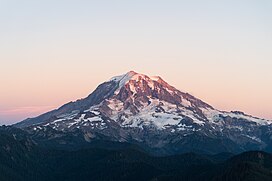
Back Rainier (berg) Afrikaans ረኒር Amharic جبل رينييه Arabic جبل رينييه ARZ রাইনিয়ার পর্বত Bengali/Bangla Mont Rainier Catalan Mount Rainier (bukid) CEB Mount Rainier Czech Mount Rainier Danish Mount Rainier German
| Mount Rainier | |
|---|---|
| Tahoma | |
 Mount Rainier's northwestern slope viewed aerially just before sunset on September 6, 2020 | |
| Highest point | |
| Elevation | 14,411 ft (4,392 m) NAVD 88[1][2] |
| Prominence | 13,246 ft (4,037 m)[1] |
| Parent peak | Mount Massive, United States of America[1] |
| Isolation | 731 mi (1,176 km)[1] |
| Listing | |
| Coordinates | 46°51′11″N 121°45′38″W / 46.85306°N 121.76056°W[1] |
| Naming | |
| Etymology | Peter Rainier |
| Geography | |
| Country | United States |
| State | Washington |
| County | Pierce County |
| Protected area | Mount Rainier National Park |
| Parent range | Cascade Range |
| Topo map | USGS Mount Rainier West |
| Geology | |
| Age of rock | 500,000 years |
| Mountain type | Stratovolcano |
| Volcanic arc | Cascade Volcanic Arc |
| Climbing | |
| First ascent | 1870 by Hazard Stevens and P. B. Van Trump |
| Easiest route | rock/ice climb via Disappointment Cleaver |
Mount Rainier (/reɪˈnɪər/ ray-NEER), also known as Tahoma, is a large active stratovolcano in the Cascade Range of the Pacific Northwest in the United States. The mountain is located in Mount Rainier National Park about 59 miles (95 km) south-southeast of Seattle.[3] With a summit elevation of 14,411 ft (4,392 m),[4][5] it is the highest mountain in the U.S. state of Washington, the most topographically prominent mountain in the contiguous United States,[6] and the tallest in the Cascade Volcanic Arc.
Due to its high probability of an eruption in the near future and proximity to a major urban area, Mount Rainier is considered one of the most dangerous volcanoes in the world, and it is on the Decade Volcano list.[7] The large amount of glacial ice means that Mount Rainier could produce massive lahars that could threaten the entire Puyallup River valley and other river valleys draining Mount Rainier, including the Carbon, White, Nisqually, and Cowlitz (above Riffe Lake).[8] According to the United States Geological Survey, "about 80,000 people and their homes are at risk in Mount Rainier's lahar-hazard zones."[9]
Between 1950 and 2018, 439,460 people climbed Mount Rainier.[10][11] Approximately 84 people died in mountaineering accidents on Mount Rainier from 1947 to 2018.[10]
- ^ a b c d e "Mount Rainier, Washington". Peakbagger.com. Retrieved January 1, 2016.
- ^ "Topographic map of Mount Rainier". opentopomap.org. Retrieved February 24, 2024.
- ^ Egan, Timothy (August 22, 1999). "Respecting Mount Rainier". The New York Times. Archived from the original on March 11, 2022. Retrieved March 10, 2022.
- ^ Cite error: The named reference
elevationwas invoked but never defined (see the help page). - ^ Signani, Larry (July 19, 2000). "The Height of Accuracy". Point of Beginning. BNP Media. Archived from the original on December 17, 2012. Retrieved January 30, 2023.
- ^ "USA Lower 48 Top 100 Peaks by Prominence". Peakbagger.com.
- ^ "Decade Volcanoes". CVO. United States Geological Survey. Archived from the original on June 3, 2012.
- ^ "Volcanic Hazards at Mount Rainier | U.S. Geological Survey". www.usgs.gov. Retrieved March 22, 2024.
- ^ Driedger, C.L.; Scott, K.M. (March 1, 2005). "Mount Rainier – Learning to Live with Volcanic Risk". Fact Sheet 034-02. United States Geological Survey. Archived from the original on July 20, 2010. Retrieved October 30, 2008.
- ^ a b Emma P. DeLoughery; Thomas G. DeLoughery (June 14, 2022). "Review and Analysis of Mountaineering Accidents in the United States from 1947–2018". High Altitude Medicine & Biology. 23 (2): 114–18. doi:10.1089/ham.2021.0085. PMID 35263173. S2CID 247361980. Archived from the original on July 11, 2022. Retrieved July 11, 2022.
- ^ "Annual Climbing Statistics". National Park Service. Archived from the original on July 11, 2022. Retrieved July 11, 2022.
© MMXXIII Rich X Search. We shall prevail. All rights reserved. Rich X Search
